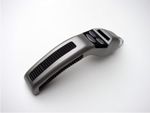|
The personal phaser is the primary sidearm of Starfleet personnel.
Operation
The phaser energy is released through the application of the Rapid Nadion Effect (RNE). Rapid nadions are short-lived subatomic particles possessing special properties related to high-speed interactions within atomic nuclei. Among these properties is the ability to liberate and transfer strong nuclear forces within a particular class of super-conducting crystals known as fushigi-no-umi. The crystals were so named when it appeared to researchers at Starfleet's Tokyo R&D facility that the materials being developed represented a virtual "sea of wonder" before them.
Types
Two types of personal phasers are currently in use:
- Type 1 Phaser, mainly used as a back-up weapon, in critical diplomatic situations, or when a more covert weapon is required.
- Type 2 Phaser, the standard armament for away teams.
More powerful phaser rifles and other weapons are also available for special circumstances and missions when heavy hostile retaliation is expected.
Current Models
Type 1 Phaser
Because of their small size, type 1 phasers are informally known as "cricket" phasers by Starfleet personnel. The current type 1 phaser model was introduced in 2373.
Type 2 Phaser
Type 2 Phaser with power cells exposed
The current Type 2 phaser model was introduced in 2379. This model in particular is informally referred to by personnel as a "dolphin" phaser because of its redesigned emitter compared to earlier models.
Type 2 "Aquila" Pattern
Type 2 "Aquila" Mk VIII NL
- Mark VII: An updated model of the standard Type 2 that was used throughout the early 24th Century, the Aquila pattern was designed for use by the Federation Marine Corps, Starfleet Hazard teams, and for more robust away missions. Built on the more sturdy ancient Terran design for firearms, the Aquila was designed to be more durable and further in line with the primary weapons often used by the marines. Along with these design improvements the Starfleet Corps of Engineers simplified the power scale and restructured the emitter to fire phaser pellets instead of a concentrated phaser beam. This change removed the Aquila from a ‘tool’ category and grounded it firmly as a weapon. Instead of a scaling power level from one to sixteen, which was used primarily to credit the original models as a cutting tool, the Aquila has five settings. Light Stun, Heavy Stun, Disruption, Lethal (Kill), and Disintegrate. The final setting has a limited range and spends the weapons power supply quickly. A digital readout on the right and left side of the weapon displays the remaining charge and current setting.
- Mark VIII NL: Taking familiar physical elements from its Mark VII predecessor, the Mark VIII NL (Non-Lethal) is designed more for defense of the user, rather than acting as an assault weapon commonly used by marines. It became accessible to Starfleet personnel as of 2390, and may often be seen holstered by officers on independent assignments on recently colonized worlds, where the chance of a weapon being stolen is much greater than during a ship's regular away mission. The Mark VIII NL is non-lethal, firing energy stun bolts. Despite its obvious similarity to the Mark VII, notable differences include a grip pulled back towards the end of a thinner barrel, of which slides forward for power pack replacements, as well as a complete overhaul in settings (potential for "kill" settings having been completely removed, with death of the intended target now unlikely even at the Mark VIII NL's highest setting). Despite falling under the Type 2 phaser category, the Mark VIII NL is only capable of a maximum level four intensity. The intention of the simplistic Mark VIII NL is for the weapon to remain holstered and drawn only as a last resort, making it ideal for officers in first contact or political scenarios.
Specifications
- Beam Intensity Settings:
- Type 1 Phaser: 1 through 8
- Type 2 Phaser: 1 through 16
- Type 2 Mk VII: 1, 3, 7, 9 and 12
- Type 2 Mk VIII NL: 1 through 4
| Power Setting
|
Effect
|
| 1 Light Stun
|
Knocks out base-type humanoids for up to five minutes.
|
| 2 Medium Stun
|
Knocks out base-type humanoids for up to 15 minutes.
|
| 3 Heavy Stun
|
Knocks out base-type humanoids for up to 1 Hour.
|
| 4 Thermal Effects
|
Causes neural damage and skin burns to base-type humanoids.
|
| 5 Thermal Effects
|
Causes severe burn effects to humanoid tissue.
|
| 6 Disruption Effects
|
Causes matter to disassociate and deeply penetrates organic tissue.
|
| 7 Disruption Effects
|
Kills humanoids as disruption effects become widespread.
|
| 8 Disruption Effects
|
Cascading disruption forces vaporise humanoid organisms. Maximum setting for type I phasers.
|
| 9 Disruption Effects
|
Damage to heavy alloy and ceramic materials over 100cm thick.
|
| 10 Disruption Effects
|
Heavy alloy and ceramic materials over 100cm thick are vaporised.
|
| 11 Disruption / Explosive Effects
|
Ultra dense alloy materials vaporise. Light geological displacement.
|
| 12 Disruption / Explosive Effects
|
Ultra dense alloy materials vaporise. Medium geological displacement.
|
| 13 Disruption / Explosive Effects
|
Light vibrations to shielded matter. Medium geological displacement.
|
| 14 Disruption / Explosive Effects
|
Medium vibrations to shielded matter. Heavy geological displacement.
|
| 15 Disruption / Explosive Effects
|
Major vibrations to shielded matter. Heavy geological displacement.
|
| 16 Disruption / Explosive Effects
|
Shielded matter fractures. Heavy geological displacement. Maximum setting for type II phasers.
|
|
|






